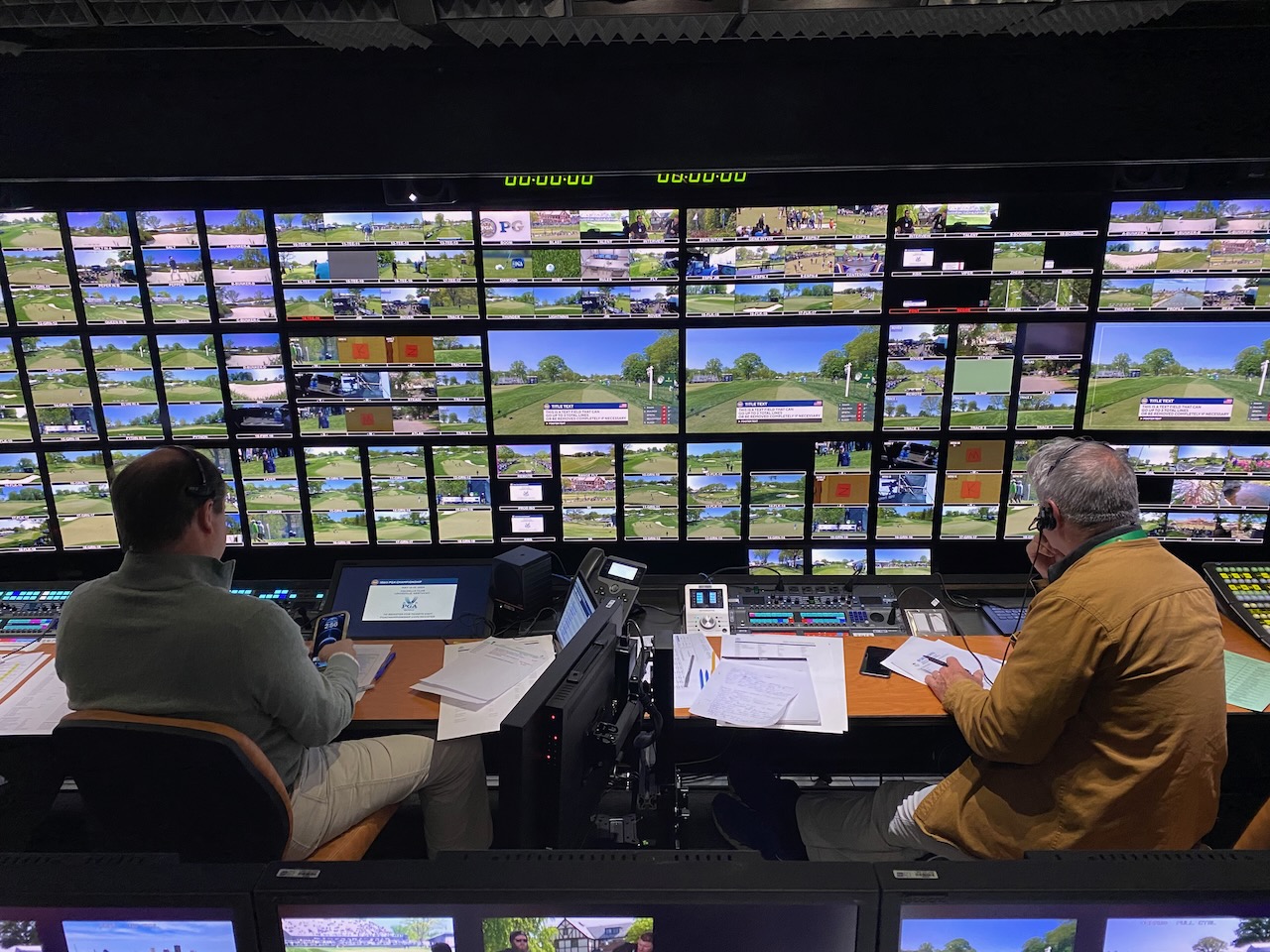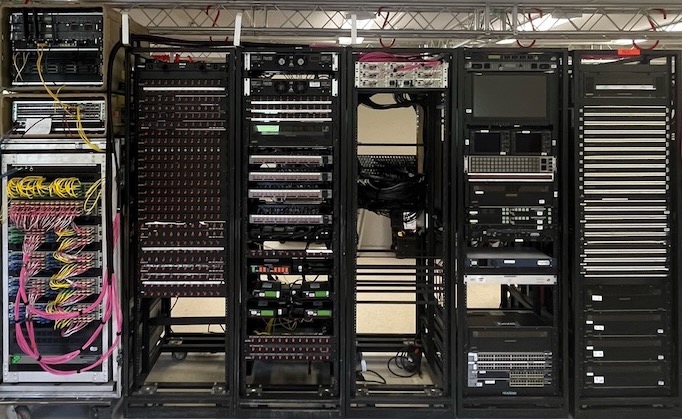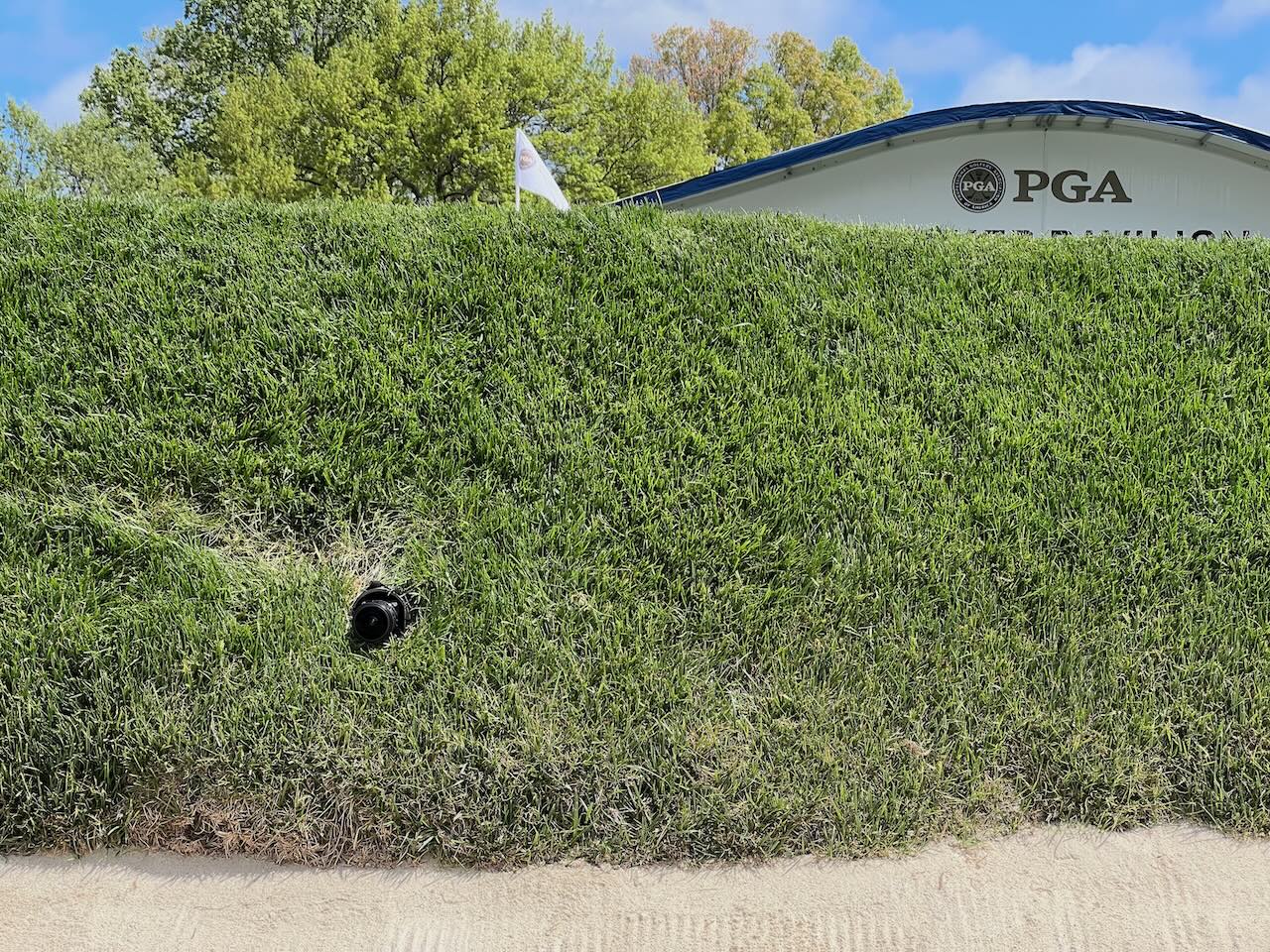CBS Sports Goes Fully IP for PGA Championship
NEP TFC helps connect compound; C360 camera boosts flexibility of bunker coverage
Story Highlights
As the PGA Championship’s first round begins today, so does a new era for CBS Sports. The compound at Oak Hill Country Club in Rochester, NY, has made the leap to IP and ST 2110, a move that is going to make a difference not just to those working the event but also to viewers at home.
“We started this IP journey in 2015 with [NEP] Supershooter CBS,” says Mike Francis, VP, engineering and technology, CBS Sports. “We needed a truck that could keep up with the expanding show. It’s a dream realized. Back in 2015, we said, ‘Won’t it be great someday when we all just connect to a central switch and can get everything?’ That is finally here.”

Game Creek Video Prime mobile unit will handle back-nine duties for the PGA Championship beginning today.
The improvements were evident this week in much easier compound setup. Previously, the compound was built on a hub-and-spoke model, which required a couple of days of setup and a truck in the middle of the compound managing all the feeds for rightsholders, featured groups, featured holes, etc.
“It was manpower-intensive,” says Francis, “not the latest and greatest in technology.”
Meetings between the CBS team, NEP, Game Creek, and F&F, along with Lawo, Evertz, and Grass Valley on the routing side, set in motion the new ST 2110 workflow. The linchpin has been the use of NEP TFC (Total Facility Control), a proprietary software platform designed to enable greater signal control and monitoring. With TFC at the center, the compound moved from a hub-and-spoke to a spine-and-leaf network with fiber strands from the TFC to each truck, allowing anyone anywhere to access the audio and video signals they need while also providing redundancy.
“It makes us more robust as we don’t lose everything if a strand goes down,” says Francis. “It has also helped with signal timing and streamlined the several-hour procedure we used to have to set that up.”
TFC replaces a large flypack comprising about 15 racks of gear and reduces the footprint to four racks that feed into one rack of network switches.
“TFC was the obvious choice because of the level of customization,” says Francis. “It’s the center point and can translate [signals] between gear from other manufacturers. It also allows us to be more flexible and dynamic: changing something is as simple as making a route inside the truck, and the various truck engineers can coordinate things.”
It also will increase the amount of traffic, with about 2 TB of data passing through the network every second.
“For the first time ever,” he says, “those involved in shoulder programming will have access to everything they need. This really does make everything better. And we can grow our main show more efficiently. We’re excited about what this opens up for the future at our tentpole events.”
The IP network also allows the engineering team to check the fidelity of a signal end-to-end without needing to leave a computer screen.
“With coax, at some point, you need to pull it off the intended recipient and plug it into a test monitor to confirm the signal will make it to the other end,” Francis points out. “One of the great things about IP is, we can monitor the whole process without needing to do that.”
The IP network will be handling signals from more than 120 cameras on the course, and, according to Francis, there will be more than 400 channels of record between EVS and Hawkeye. In addition, eight production switchers will be in use along with a big audio network with more than 100 microphones.
“We’ve been able to utilize IP to get all the audio signals where they need to go,” he says. “IP has streamlined the audio/video timing and makes sure they match each other.”
As for event coverage, Supershooter CBS is responsible for the front nine; Game Creek Prime, the back nine. F&F GTX20 will handle featured-hole coverage, and GTX19 is onsite for the On the Range show on CBS Sports Network. Game Creek Columbia, Celtic, and Centennial will handle the featured groups, featured holes, and ESPN SportsCenter coverage.
ESPN’s efforts illustrate how the new workflow is already paying off.
“We [previously] had to do a lot of subrouting of around 40 feeds to the ESPN truck,” Francis explains. “Now, by virtue of the network, they can have every camera or record versus having to get something off the EVS network. It has streamlined everything.”
On the Course
The advances in the compound have been matched by advances in course coverage. Each course offers its own set of opportunities for golf coverage (and new technologies), and Oak Hill is no exception.
“The big story here is the bunkers,” says Francis. “Some of them are pretty ferocious. We’re putting in bunker cams, but the greenside bunker at the 15th hole can be hit-or-miss depending on where you place the cameras. We’re using a C360 camera, which gives us a much wider view of the action. It’s a unique way to use that technology.”
The C360 bunker cam is complemented by four mini robotic cameras embedded in two greenside bunkers on the drive-able par-4 14th hole. Also, two Flycam systems will be deployed: one spanning nearly 1,200 ft. from the practice facility to the 1st and 18th holes, the other along the 13th green and 14th tee. The Flycams have the ability to track virtual graphics with augmented-reality technology, sweeping past (or through) graphics that viewers see on-screen.
“The Flycams also have Z-axis capability,” adds Francis. “They are not only point-to-point but can go up and down. Our director Steve Milton likes to show different perspectives and get different things in the foreground.”
Another piece of tech providing a different perspective is a curved railcam that will be in use on the “Hill of Fame” just off the 17th hole. “It will give us a lot of beauty shots that everyone in the compound can take advantage of,” says Francis.
CBS will also be using the Atlas camera, which has been upgraded to a Sony FX6 for shallow depth of field (also in the mix will be Sony F-5500’s that allow the team to flip a switch for use in either standard handheld or shallow–depth-of-field mode). A Sony FX9 will be deployed with a Steadicam rig.
“We find the image quality on the FX6 is better over all and gives us a little more control over paint and things like that,” says Francis. “And the operators are getting better at understanding where they need to be in relation to their subject matter.”
Other tech highlights include Toptracer on all 18 holes (and the practice range) and four RF mini cameras allowing ball-tracking graphics and statistics from the fairway. Shotlink and virtual flyover animations are also being deployed.
“All the tracing operators are working remotely from the CBS Broadcast Center in New York City,” notes Francis.
There will be other remote activity as well, with an ARL team in Dunedin, New Zealand, and Hawkeye operators handling replay from locations across the U.S. A wind system from Pinpoint system will be operated both remotely and onsite, depending on the feed.
The Switch is onsite with a broadcast truck providing Ethernet, video, and Internet services. Having installed 20 Gbps of protected local loops to its dedicated fiber backbone, it is delivering video, point-to-point data, and internet services to broadcast partners ESPN, CBS, and Golf Channel.
Other vendors involved include BSI, Fletcher, Robovision, and CAT Entertainment Services.
Francis gives a shout-out to the CBS Sports team: Patty Power, EVP, operations and engineering; Jason Cohen, VP, remote technical operations; Tom McShane, VP, remote operations; Scott Davis, VP, broadcast operations; Ed Coleman, VP, post production and media operation; Craig Stevens; Evelyn Jackson, manager, venue engineering and planning; Adam Stouter, senior director, remote technical Operations; Kristen Florian, director, remote operations planning; Jeff Millet, manager, remote engineering and planning; George Dimotheris, director, broadcast production/operations; and Alyssa Blake, senior director, broadcast operations and solutions. “It’s a true team effort.”


